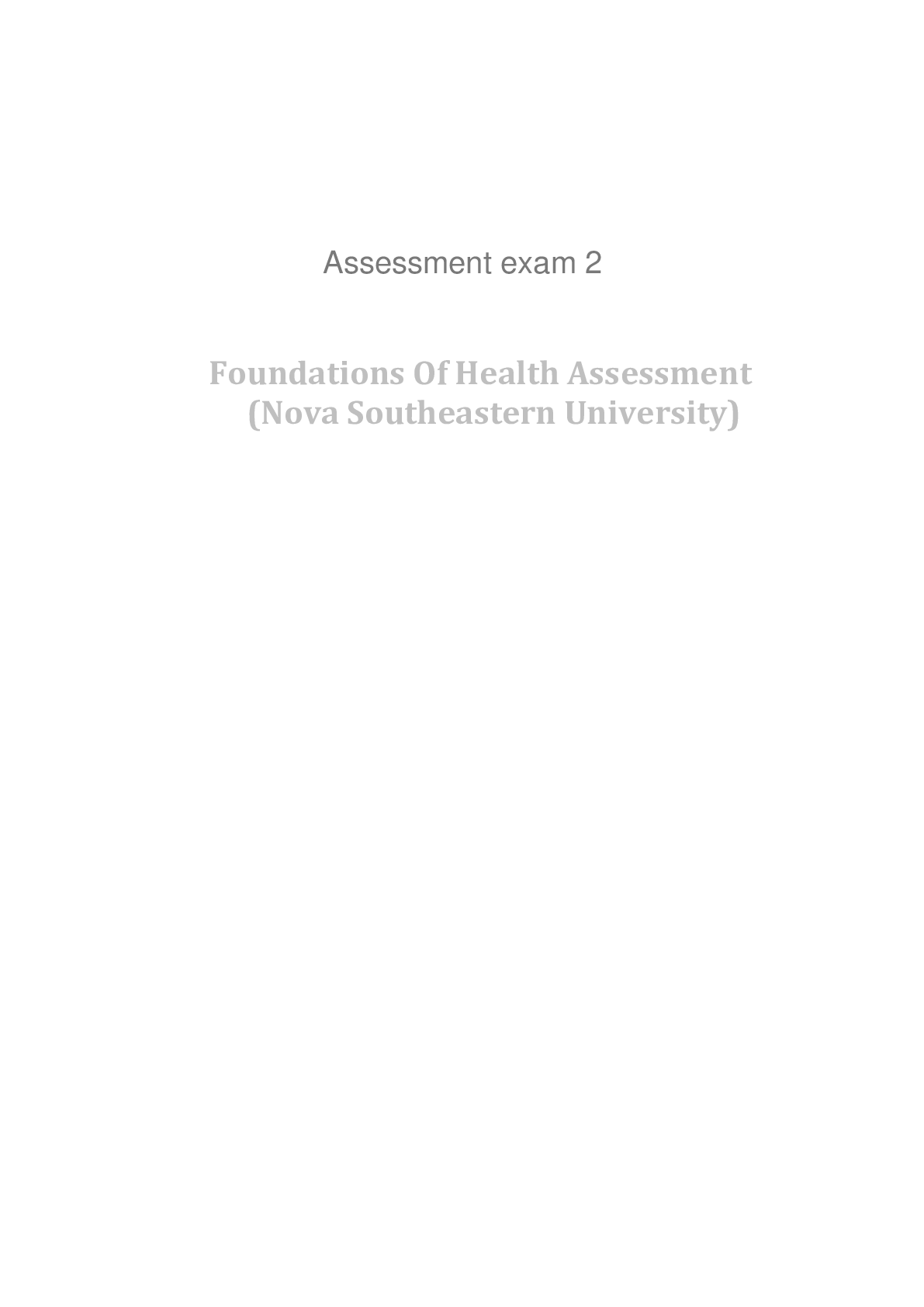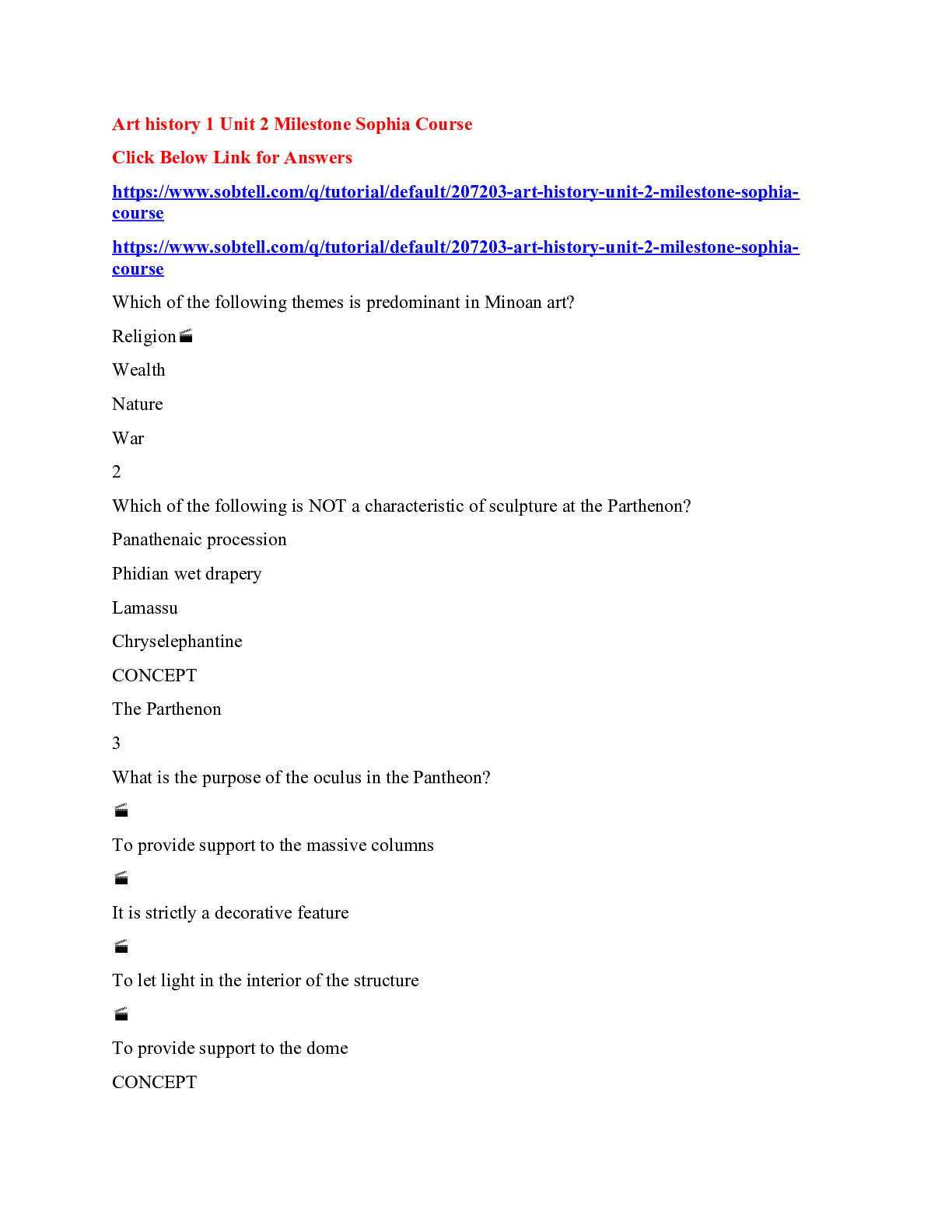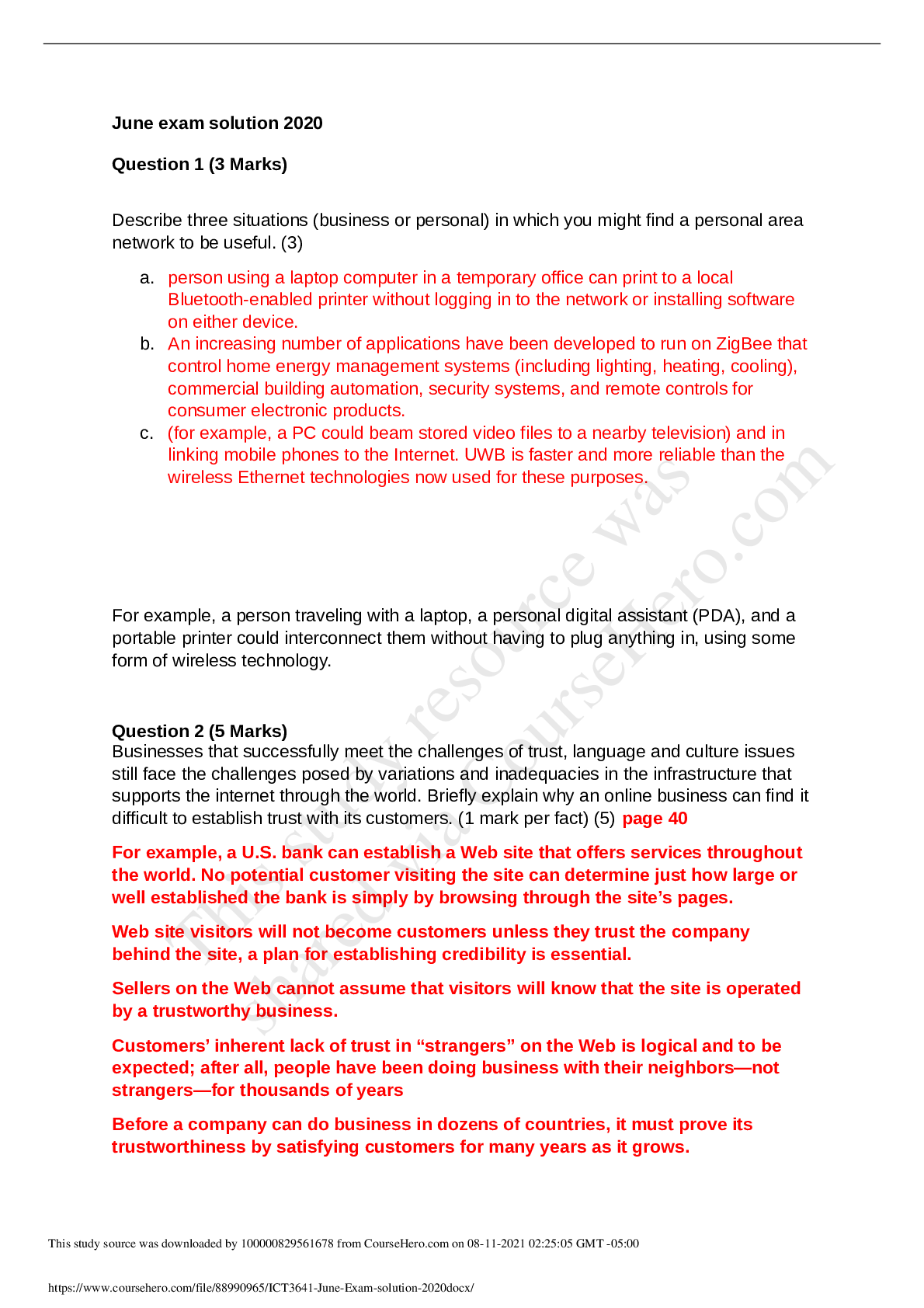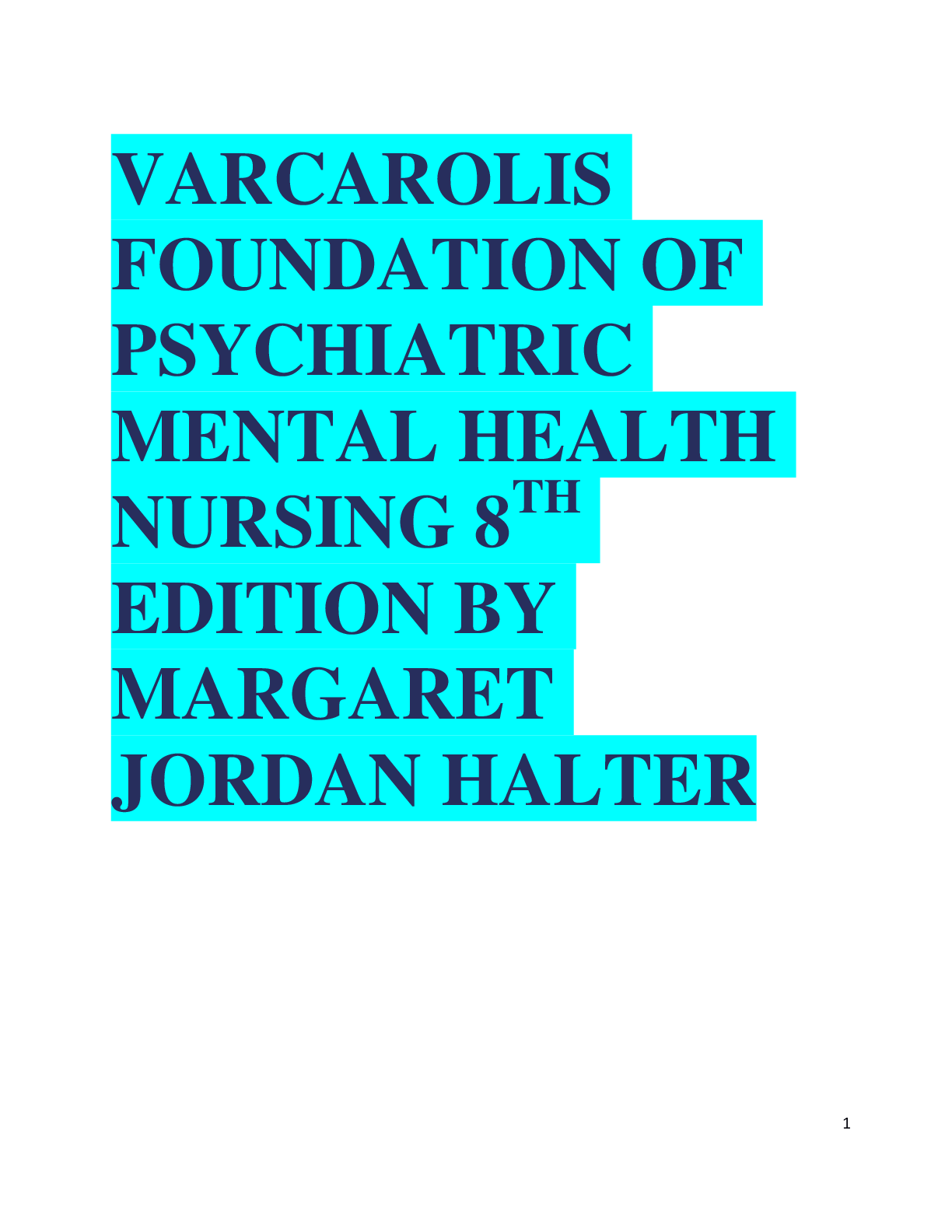*NURSING > EXAM REVIEW > Chapter 08: Therapeutic Relationships Halter: Varcarolis’ Foundations of Psychiatric Mental Health (All)
Chapter 08: Therapeutic Relationships Halter: Varcarolis’ Foundations of Psychiatric Mental Health Nursing: A Clinical Approach, 8th Edition(Best Solutions)
Document Content and Description Below
1. A nurse assesses a confused older adult. The nurse experiences sadness and reflects, ―This patient is like one of my grandparents … so helpless.‖ Which response is the nurse demonstrating? ... a. Transference b. Countertransference c. Catastrophic reaction d. Defensive coping reaction 100 ANS: B Countertransference is the nurse‘s transference or response to a patient that is based on the nurse‘s unconscious needs, conflicts, problems, or view of the world. See relationship to audience response question. PTS: 1 DIF: Cognitive Level: Understand (Comprehension) REF: Pages 8-10 to 12, 35 (Table 8-2) TOP: Nursing Process: Assessment MSC: Client Needs: Psychosocial Integrity 2. Which statement shows a nurse has empathy for a patient who made a suicide attempt? a. ―You must have been very upset when you tried to hurt yourself.‖ b. ―It makes me sad to see you going through such a difficult experience.‖ c. ―If you tell me what is troubling you, I can help you solve your problems.‖ d. ―Suicide is a drastic solution to a problem that may not be such a serious matter.‖ ANS: A Empathy permits the nurse to see an event from the patient‘s perspective, understand the patient‘s feelings, and communicate this to the patient. The incorrect responses are nursecentered (focusing on the nurse‘s feelings rather than the patient‘s), belittling, and sympathetic. PTS: 1 DIF: Cognitive Level: Apply (Application) REF: Pages 8-22, 23 TOP: Nursing Process: Evaluation MSC: Client Needs: Psychosocial Integrity 3. After several therapeutic encounters with a patient who recently attempted suicide, which occurrence should cause the nurse to consider the possibility of countertransference? a. The patient‘s reactions toward the nurse seem realistic and appropriate. b. The patient states, ―Talking to you feels like talking to my parents.‖ c. The nurse feels unusually happy when the patient‘s mood begins to lift. d. The nurse develops a trusting relationship with the patient. ANS: C Strong positive or negative reactions toward a patient or over-identification with the patient indicate possible countertransference. Nurses must carefully monitor their own feelings and reactions to detect countertransference and then seek supervision. Realistic and appropriate reactions from a patient toward a nurse are desirable. One incorrect response suggests transference. A trusting relationship with the patient is desirable. See relationship to audience response question. PTS: 1 DIF: Cognitive Level: Apply (Application) REF: Pages 8-10 to 12, 35 (Table 8-2) TOP: Nursing Process: Evaluation MSC: Client Needs: Psychosocial Integrity 101 4. A patient says, ―Please don‘t share information about me with the other people.‖ How should the nurse respond? a. ―I will not share information with your family or friends without your permission, but I will share information about you with other staff.‖ b. ―A therapeutic relationship is just between the nurse and the patient. It is up to you to tell others what you want them to know.‖ c. ―It depends on what you choose to tell me. I will be glad to disclose at the end of each session what I will report to others.‖ d. ―I cannot tell anyone about you. It will be as though I am talking about my own problems, and we can help each other by keeping it between us.‖ ANS: A A patient has the right to know with whom the nurse will share information and that confidentiality will be protected. Although the relationship is primarily between the nurse and patient, other staff needs to know pertinent data. The other incorrect responses promote incomplete disclosure on the part of the patient, require daily renegotiation of an issue that should be resolved as the nurse–patient contract is established, and suggest mutual problem solving. The relationship must be patient centered. See relationship to audience response question. PTS: 1 DIF: Cognitive Level: Apply (Application) REF: Pages 8-18, 19 TOP: Nursing Process: Implementation MSC: Client Needs: Safe, Effective Care Environment 5. A nurse is talking with a patient, and 5 minutes remain in the session. The patient has been silent most of the session. Another patient comes to the door of the room, interrupts, and says to the nurse, ―I really need to talk to you.‖ The nurse should a. invite the interrupting patient to join in the session with the current patient. b. say to the interrupting patient, ―I am not available to talk with you at the present time.‖ c. end the unproductive session with the current patient and spend time with the interrupting patient. d. tell the interrupting patient, ―This session is 5 more minutes; then I will talk with you.‖ ANS: D When a specific duration for sessions has been set, the nurse must adhere to the schedule. Leaving the first patient would be equivalent to abandonment and would destroy any trust the patient had in the nurse. Adhering to the contract demonstrates that the nurse can be trusted and that the patient and the sessions are important. The incorrect responses preserve the nurse–patient relationship with the silent patient but may seem abrupt to the interrupting patient, abandon the silent patient, or fail to observe the contract with the silent patient. PTS: 1 DIF: Cognitive Level: Apply (Application) REF: Pages 8-18, 19, 35 (Table 8-2) | Page 8-39 (Table 8-3) TOP: Nursing Process: Implementation MSC: Client Needs: Safe, Effective Care Environment 102 6. Termination of a therapeutic nurse–patient relationship has been successful when the nurse a. avoids upsetting the patient by shifting focus to other patients before the discharge. b. gives the patient a personal telephone number and permission to call after discharge. c. discusses with the patient changes that happened during the relationship and evaluates outcomes. d. offers to meet the patient for coffee and conversation three times a week after discharge. ANS: C Summarizing and evaluating progress help validate the experience for the patient and the nurse and facilitate closure. Termination must be discussed; avoiding discussion by spending little time with the patient promotes feelings of abandonment. Successful termination requires that the relationship be brought to closure without the possibility of dependency-producing ongoing contact. PTS: 1 DIF: Cognitive Level: Apply (Application) REF: Pages 8-20, 21 TOP: Nursing Process: Evaluation MSC: Client Needs: Safe, Effective Care Environment 7. What is the desirable outcome for the orientation stage of a nurse–patient relationship? The patient will demonstrate behaviors that indicate a. self-responsibility and autonomy. b. a greater sense of independence. c. rapport and trust with the nurse. d. resolved transference. ANS: C Development of rapport and trust is necessary before the relationship can progress to the working phase. Behaviors indicating a greater sense of independence, self-responsibility, and resolved transference occur in the working phase. PTS: 1 DIF: Cognitive Level: Understand (Comprehension) REF: Pages 8-17 to 19 TOP: Nursing Process: Outcomes Identification MSC: Client Needs: Psychosocial Integrity 8. During which phase of the nurse–patient relationship can the nurse anticipate that identified patient issues will be explored and resolved? a. Preorientation b. Orientation c. Working d. Termination ANS: C 103 During the working phase, the nurse strives to assist the patient in making connections among dysfunctional behaviors, thinking, and emotions and offers support while alternative coping behaviors are tried. PTS: 1 DIF: Cognitive Level: Understand (Comprehension) REF: Pages 8-19, 20 TOP: Nursing Process: Planning MSC: Client Needs: Psychosocial Integrity 9. At what point in the nurse–patient relationship should a nurse plan to first address termination? a. During the orientation phase b. At the end of the working phase c. Near the beginning of the termination phase d. When the patient initially brings up the topic ANS: A The patient has a right to know the conditions of the nurse–patient relationship. If the relationship is to be time-limited, the patient should be informed of the number of sessions. If it is open-ended, the termination date will not be known at the outset, and the patient should know that the issue will be negotiated at a later date. The nurse is responsible for bringing up the topic of termination early in the relationship, usually during the orientation phase. PTS: 1 DIF: Cognitive Level: Understand (Comprehension) REF: Pages 8-17, 18 TOP: Nursing Process: Implementation MSC: Client Needs: Psychosocial Integrity 10. A nurse introduces the matter of a contract during the first session with a new patient because contracts a. specify what the nurse will do for the patient. b. spell out the participation and responsibilities of each party. c. indicate the feeling tone established between the participants. d. are binding and prevent either party from prematurely ending the relationship. ANS: B A contract emphasizes that the nurse works with the patient rather than doing something for the patient. ―Working with‖ is a process that suggests each party is expected to participate and share responsibility for outcomes. Contracts do not, however, stipulate roles or feeling tone, and premature termination is forbidden. [Show More]
Last updated: 1 year ago
Preview 1 out of 13 pages
.png)
Reviews( 0 )
Document information
Connected school, study & course
About the document
Uploaded On
May 04, 2021
Number of pages
13
Written in
Additional information
This document has been written for:
Uploaded
May 04, 2021
Downloads
0
Views
48
.png)



.png)


.png)





.png)
.png)









.png)
.png)
.png)
.png)
.png)
.png)
.png)
.png)
.png)
.png)
.png)
.png)

